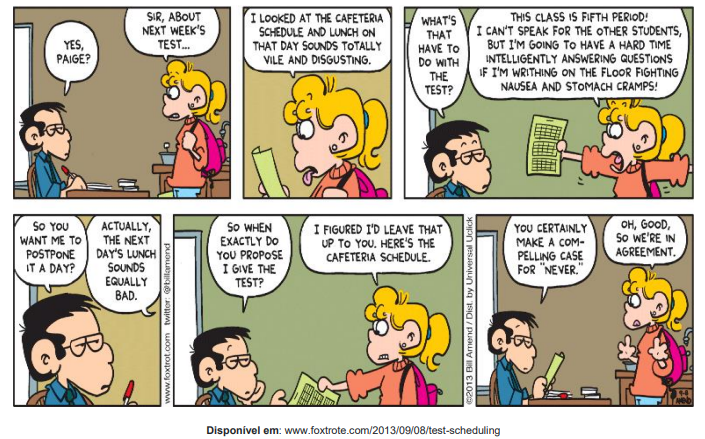Questões de Inglês para Concurso
Foram encontradas 16.398 questões
Leia a tirinha a seguir e responda a questão.

Leia o fragmento de texto a seguir e responda a questão.
Cultural stereotypes are fixed ideas that people have about what specific social groups or individuals are like, especially an idea that is wrong. Other terms that are associated with the term stereotype are prejudice and cliché. The term has a Greek origin: stereos means solid or firm and typos mean blow, impression, engraved, or mark. The term was first used in the printing business. The first modern English use of the term was in 1850, meaning “image perpetuated without change.”
Because stereotypes are standardized and simplified ideas of groups based on some prejudices, they are not derived from objective facts but rather from subjective and often unverifiable ideas. As Sociologist Charles E. Hurst states, “one reason for stereotypes is the lack of personal, concrete familiarity that individuals have with persons in other racial or ethnic groups. Lack of familiarity encourages the lumping together of unknown individuals”.
The existence of stereotypes may be explained by the need for groups of people to view themselves as more normal or superior to other groups. Consequently, stereotypes may be used to justify ill-founded prejudices or ignorance and prevent people of stereotyped groups from entering or succeeding in various activities or fields. The stereotyping group is, generally, reluctant to reconsider their attitudes and behavior towards the stereotyped group.
Stereotypes may affect people negatively. This includes forming inaccurate and distorted images and opinions of people. Stereotypes may also be used for scapegoating or for making general erroneous judgments about people. Some stereotyping people may feel comfortable when they prevent themselves from emotional identification with the stereotyped group, which leads to xenophobic or racist behavior. Finally, another serious consequence of stereotypes is the feeling of inferiority that the stereotyped people may have, which may impair their performance.
Fonte: HURST, Charles. Social Inequality: Forms, Causes
and Consequences. Boston: Pearson Education, 2007.
I. Estereótipos são ideias padronizadas e derivadas de fatos objetivos sobre grupos ou indivíduos que se comportam de maneira errada na sociedade. II. Vem do grego a origem do termo estereótipo, sendo que o uso do termo teve início no contexto do ramo gráfico. III. O sentimento de inferioridade é uma das consequências que as pessoas que sofrem por estereótipos podem vir a sentir. IV. Há pessoas que são estereotipadas porque, por vezes, aparentam se mostrar superiores a outras pessoas. V. Segundo o sociólogo Charles E. Hurst, a falta de familiaridade com indivíduos de outros grupos étnicos e raciais é uma causa para a construção de estereótipos.
Assinale a alternativa CORRETA.
( ) Similar kinds of analyses can diagnose two other forms of complexity. (Times, Sunday Times, 2009). ( ) The sanctuary needed more humdrum fowl, more farmyard ducks and geese. (Ballard, J. G. Rushing to Paradise, 2002). ( ) The animals closely resemble wolfes, howl, and are more likely to be aggressive. (Times, Sunday Times, 2012). ( ) The iris of their eyes have an unusual lacy appearance. (Wills, C. The Runaway Brain: the Evolution of Human Uniqueness, 1993). ( ) Your older brother has been thrown in jail for his political beliefs. (Times, Sunday Times, 2007).
Assinale a alternativa que apresenta a sequência CORRETA.
Caring for Puppies
Larry was a kind-hearted boy. He was known for his compassion and love for animals. One sunny morning, he found a cardboard box near the park. To his surprise, it was filled with a litter of adorable puppies. The puppies were shivering and hungry, their eyes barely open. Without hesitation, Larry scooped them up and took them home. He knew he had to care for them. As the time passed by, Larry's bond with the puppies deepened. He spent hours playing with them, making sure they were happy and healthy. He watched them grow. Each time he walked into the room, their tiny tails wagged in excitement. Word quickly spread about a boy caring for the abandoned puppies. Soon, the neighborhood kids joined in to help. They assisted Larry in finding loving homes for the puppies. When the day came to say goodbye, Larry felt a mix of emotions. He knew he would miss them dearly as the new owners took the puppies home. But he felt happy when he thought his small acts of love had made a difference in the world.
Fonte: www.eslfast.com/gradedread3/gr3/gr3011.htm
Assinale a alternativa que classifica CORRETAMENTE as palavras em destaque.